Cuscuz de Milho (sweet cornmeal couscous) is a gluten-free Brazilian dish from the Northeastern region made with coconut flakes and sweetened condensed milk, served as a snack.
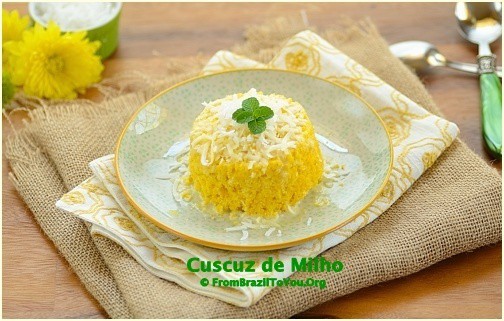
I planned to make Romeo & Juliet Stuffed French Toast but I changed my mind at the very last minute.
Instead I ended up making cuscuz de milho or cuscuz nordestino.
Preparing the couscous reminded me that I needed to show the pot that we use to make this corn dish (resembles a tamal pot but smaller).
In Brazil, the couscous pot or cuscuzeira can be found in different sizes, as you can see in the picture below.
If you don't have one, this cornmeal couscous can be made in the microwave.
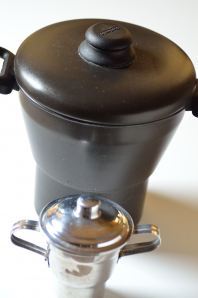
Table of Contents
Ingredients
- ½ cup good quality yellow coarse cornmeal
- ⅛ teaspoon salt
- ¼ cup water plus extra to fill the pot
- ⅓ cup coconut milk
- ¼ teaspoon sugar
- ¼ cup condensed milk for both a dairy-free and vegetarian version, omit this ingredient and add coconut milk*
- 2 tablespoons coconut flakes
- Ground cinnamon to sprinkle*
*These ingredients are not part of the traditional recipe. They reflect my personal tastes.
How To Make Cuscuz de Milho
In a medium bowl, mix the cornmeal with the salt; then add the water little by little, mixing well with your hands. Let rest for about 5 minutes.
Grease with butter both the couscous strainer plate and sides of the pot that are above the line to help cuscuz unmold easier.
Fill the bottom of the couscous pan with water (to a level slightly beneath the groove where the strainer plate rests).
Then place the strainer plate into the pot, fill the remainder of the pot above the strainer plate with the couscous mixture, and cover.
Tip: Please, do not press wettened couscous down or it won't be cooked evenly.
Bring to a boil over medium-high heat.
Reduce the heat to medium-low. Let cook for 3 - 5 minutes more (for pre-cooked cornmeal), or 8 - 10 minutes (for not pre-cooked).
Remove from heat and let cool down a bit, covered.
Meanwhile, mix both milks with sugar and the coconut flakes, stirring well. Reserve. If you wish, heat a bit the milk mixture before pouring it over cooked and unmolded cuscuz.
Remove cuscuz doce from pan, pulling it out by its aluminum stick (use gloves for this).
Invert onto a plate, separating the cuscuz de coco from the strainer plater with a butter knife.
Pour the liquid mixture over the sweet cornmeal and sprinkle cinnamon. Serve and enjoy!
Variations
While the basic cuscuz de milho recipe is simple, there are several variations you can try:
- Savory Cuscuz: Add grated melting cheese (like mozzarella), sautéed onions, or herbs like parsley or cilantro for a savory version.
- Coconut Cuscuz: For a tropical twist, mix in shredded coconut during the cooking process for a richer flavor.
- Sweet Cuscuz: If you prefer a less sweet version of our sweet cuscuz, replace condensed milk with 2 tablespoons of sugar and mix it with coconut milk for a decadent dessert.
- Meat and Egg Toppings: Top cuscuz with a fried egg, sausage, or shredded chicken or beef for a hearty meal.
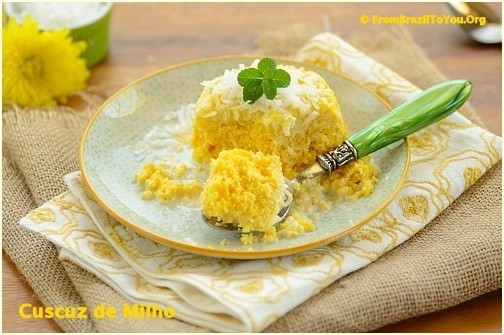
Storage and Reheating
Storing Cuscuz:
Once made, cuscuz can be stored in an airtight container in the fridge for up to 2 days. Be sure to let it cool to room temperature before storing to prevent condensation inside the container.
Reheating Cuscuz:
To reheat, simply steam the cuscuz again for a few minutes. If you don't have a steamer, you can microwave it in a microwave-safe dish. Just add a little water to keep it from drying out and heat in 30-second intervals, fluffing it with a fork in between.
For best results, reheat in small portions to ensure it heats evenly and stays fluffy.
Frequently Asked Questions
- Can I make cuscuz ahead of time?
Yes, you can make cuscuz in advance. Store it in the refrigerator and reheat it as needed. It’s perfect for meal prep! - Can I use coarse cornmeal for cuscuz?
It's best to use fine or medium cornmeal for a smoother texture. Coarse cornmeal will result in a more granular consistency. - Can I make cuscuz without a cuscuzeira?
Yes! If you don’t have a traditional cuscuzeira, simply use a regular steamer, or place wettened cornmeal loosely in a microwave-safe bowl. Cover with a paper towel and microwave on high for about 60 seconds, or until cooked and fluffy. - Can I freeze cuscuz?
While you can freeze cuscuz, it may lose some of its texture upon reheating. It's best enjoyed fresh, but if freezing, wrap it tightly and consume within a month.
Tips for making Cuscuz
Don’t skip the resting time. Let the cornmeal sit after adding water to ensure it absorbs properly.
Add flavor while steaming. For extra flavor, steam cuscuz with some aromatic herbs like bay leaves or garlic.
Be gentle when fluffing. Use a fork to fluff cuscuz gently—overworking it can make it dense.
Experiment with toppings. Cuscuz can be enjoyed with a variety of toppings like grilled meats, vegetables, or even coconut yogurt for added texture and flavor.
Cuscuz de Milho (Sweet Cornmeal Couscous) Recipe
Equipment
- steamming pot
Ingredients
- ½ cup good quality yellow coarse cornmeal
- ⅛ teaspoon salt
- ¼ cup water plus extra to fill the pot
- ⅓ cup coconut milk
- ¼ teaspoon sugar
- ¼ cup condensed milk for both a dairy-free and vegetarian version, omit this ingredient and add coconut milk*
- 2 tablespoons coconut flakes
- Ground cinnamon to sprinkle*
- *These ingredients are not part of the traditional recipe. They reflect my personal tastes.
Instructions
- In a medium bowl, mix the cornmeal with the salt; then add the water little by little, mixing well with your hands. Let rest for about 5 minutes. Grease with butter both the couscous strainer plate and sides of the pot that are above the line (this will help couscous to be unmolded much easier).
- Fill the bottom of the couscous pan with water (to a level slightly beneath the groove where the strainer plate rests); then place the strainer plate into the pot, fill the remainder of the pot above the strainer plate with the couscous mixture, and cover. Tip: Please, do not press wettened couscous down or it won't be cooked evenly.
- Bring to a boil over medium-high heat. Reduce the heat to medium-low and let cook for 3 - 5 minutes more (if cornmeal is pre-cooked), or 8 - 10 minutes (if cornmeal is not pre-cooked). Remove from heat and let cool down a bit, covered.
- Meanwhile, mix both milks with sugar and the coconut flakes, stirring well. Reserve. If you wish, heat a bit the milk mixture before pouring it over cooked and unmolded couscous.
- Remove couscous from pan, pulling it out by its aluminum stick (use gloves for this). Invert onto a plate, separating the couscous from the strainer plater with a butter knife. Pour the liquid mixture over the couscous and sprinkle cinnamon. Serve immediately. Yield: 1 cornmeal couscous that serves 2-4 people.
Recipe Notes
Nutrition
** Nutrition labels on easyanddelish.com are for educational purposes only. This info is provided as a courtesy and is only an estimate, since the nutrition content of recipes can vary based on ingredient brand or source, portion sizes, recipe changes/variations, and other factors. We suggest making your own calculations using your preferred calculator, based on which ingredients you use, or consulting with a registered dietitian to determine nutritional values more precisely.
Please note that health-focused and diet information provided on easyanddelish.com is for educational purposes and does not constitute medical advice, nor is it intended to diagnose, treat, cure, or prevent disease. Consult with your doctor or other qualified health professional prior to initiating any significant change in your diet or exercise regimen, or for any other issue necessitating medical advice.



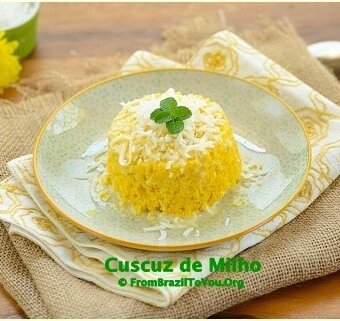
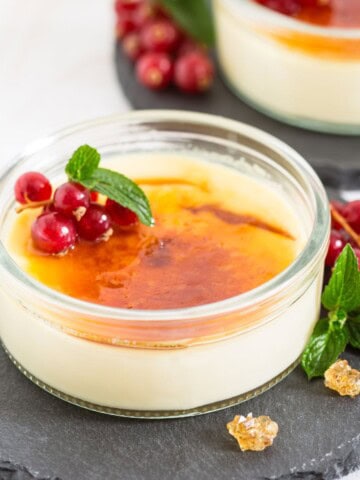

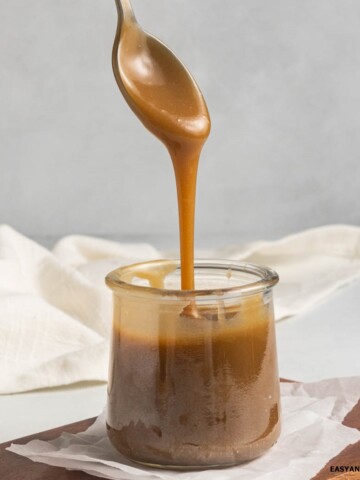
JB says
I find this dish easy to make and delicious. I also enjoy the savory variations of it.
Joy says
Oi!
Thank you so much for posting this. My fiance is from Recife and I've been trying to find a way to recreate this dish for him. When we travelled there a couple of years ago, his family prepared it with a metal funnel top-looking" mold" and it was cheesy in flavor. Do you know where I could find that mold/pot? Also, what brand of flaked corn meal is commonly used? Obrigada!!
Joy
Denise Browning says
Hi, Joy! No worries! You can moisten the couscous with water and a pinch of salt as instructed in the recipe, let rest for 5 to 10 minutes, and then place into a microwavable bowl (do not press the mixture inside the bowl. Let it loose). Microwave at high wattage for about 60 to 75 seconds. You can serve warm with cheese, melted butter on top, shredded beef, etc. The problem is the cornmeal. We have one specific for this, but it is not available everywhere. If your mother-in-law or a friend of your fiance could send it to you, it would be nice. Or you can order FLOCAO here: https://www.amazon.com/Yoki-Kimilho-Flocao-500gr/dp/B006HVPHEK
I usually buy mine at a local Latin market but not all of them carry it unfortunately. I still intend to test it with coarse polenta and something else but I cannot disclosure the info because I have not tested it yet. I hope this helps. If you have any other questions, I'll be happy to answer them.
Leo says
Oi Denise, Obrigado pela receita, sou do nordeste mas moro nos EUA tmb e decidi matar a saudade do cuzcuz! Voce poderia indicar uma marca de coarse cornmeal? Procurei em alguns mercados aqui proximo mas so encontrei a cornmeal normal, bem fina.
Obrigado!
Denise Browning says
Oi, Leo! Prazer em tê-lo aqui visitando meu blog. Em alguns supermercado americanos, há uma marca de coarse cornmeal da Bob Red Mill ( https://www.amazon.com/Bobs-Red-Mill-Coarse-Cornmeal/dp/B005P0W5B2/ref=sr_1_8?ie=UTF8&qid=1384866279&sr=8-8&keywords=cornmeal ) que não é tão grossa como o nosso flocão mas é melhor do que as outras marcas que são de fine cornmeal. Eu compro o meu (flocão) em supermercados latinos que também vendem produtos brasileiros. Também tenho familiares e amigos que me enviam do Brasil. Se você fizer uma busca em google, você poderá encontrar algum mercado brasileiro em sua área que venda flocão.
Tracy says
Oi,
I lived in the north for over a year and loved the cuscuz but I remember it being with onions and garlic! I have always wanted to recreate that here! Can you tell me how that would be done, I have a vague recollection but not good enough to try it! Also, can you used a metal veggie steamer if you don't have anything close to the couscous pan? I am not sure I want to add another specialty pan into the kitchen if I can avoid. I could even put cheese cloth over the bottom of the veggie steamer and then put water in a pan and add the coscuz into the steamer! Que pensa??
Obrigada!
Denise Browning says
Oi, Tracy! I am from Northeast Brazil. There, we eat both savory and sweet cuscuz.
Since you seem not to have the cuscuz pan or cuscuzeira, you can improvise using a steamer for sure. If the holes on the plate of your steamer are too wide, please use a cheese cloth over the plate of the steamer so cuscuz won't fall into water. Another thing, make sure that the water that will be sitting under the plate of the steamer does not touch the cuscuz. Good luck!
If you do prefer savory cuscuz, after cornmeal is cooked (cuscuz) saute onion and garlic in a skillet and mix the cooked (and fluffed) cuscuz in it. You can add pieces of bacon, scrumbled eggs, sausage, shredded beef, vegetables, etc. I hope this helps you. Thanks for stopping by.
june says
Tenho 2 pacotes de farinha flocao pra cuscuz, mas estava querendo ver se existe um substituto pq nao sei qdo vou viajar e conseguir mais dessa farinha... Gostei... vou tentar com cornmeal da proxima q nao tiver a flocao... Quem nao tem cao caca como o gato neh? Obrigada
Denise Browning says
E verdade, June! Quem não tem cão caca com gato mesmo... 🙂 O cuzcuz nao fica exatamente igual que o flocao,em termos de textura ( cornmeal é mais fino) mas o gosto é o mesmo. O procedimento para fazer é igual ao do flocão. É muito importante não apertar o cuscuz na cuscuzeira para que o vapor circule pela massa de cuzcuz inteira e esta seja cozinhada uniformemente e fique fofinha. Um bom fim de semana e obrigada por visitar o blog.
Nami | Just One Cookbook says
Hi Denise! It's so nice to meet you and thank you for stopping by my blog. I'm happy that I found you. How interesting, I really enjoyed looking at these interesting kitchen tools! Brazilian Sweet Cornmeal Couscous looks good! I also look forward to your French toast recipe!
Denise Browning says
Nami, thanks so much for visiting my blog! I am already a fan of yours.
The french toast will be prepared a few minutes from now and posted tomorrow. I hope you enjoy it. Have a great day!
Joanne Tran says
Hi there,
I cant find corn meal in my country. Can i use polenta?
Thank you
joann
Denise Browning says
Hi, Joanne! You may try it but I can't guarantee the results would be the same. For sure, it won't be as fluffy as the one that I used here called "flocao". Make sure to not press the wet coarse cornmeal or polenta. It's supposed to be wet and flaky so it has a better chance to cook uniformly. Thanks for stopping by!
Joanne Tran says
Hi there can i use a ramekin, I dont have the same cookibg bowl like you. To cook in the pot. Help me.
Joanne Tran says
Hi there
My cornmeal is 100 percent cornmeal, is that pre cooked?
Denise Browning says
Hi, Joanne! The cornmeal that we use to make this dish in Brazil is partially cooked and has a coarse texture.